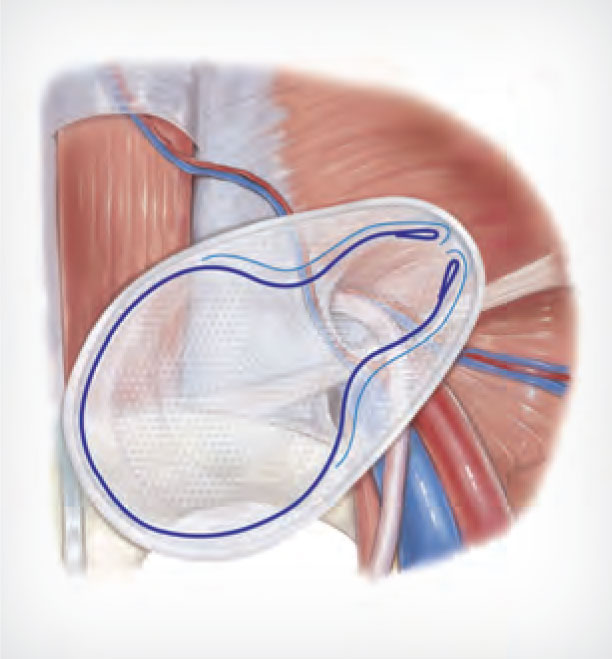RELATED PRODUCTS NOT AVAILABLE
true
Support
Becton Dickinson Australia & New Zealand
AU: 1800 656 100
NZ: 0800 572 468
Thank you for contacting our sales team!
A sales representive will get in touch with you shortly.
For more information, please visit our Contact Us page


- Overview
- Products & Accessories
- EIFU & Resources
Same proven technique with improved mesh
OnFlex™ Mesh was specifically designed to fit the inguinal anatomy during preperitoneal placement. It offers extended medial and inferior coverage for direct and femoral hernia spaces.
true
Lightweight, Large Pore Mesh
- Reduces the amount of foreign material implanted
- Allows good tissue ingrowth1*
- Results in a more flexible and compliant scar formation1
Positioning Pocket
- Medial pocket aids in proper placement
Absorbable SorbaFlex™ Memory Technology
- Allows the patch to open and conform to the anatomy
- Aids in the proper positioning of the device
Interrupted PDO Monofilament
- Enables easy mesh insertion into the preperitoneal space
Inguinal Notch
- Designed to conform to the iliac vessels
1 Brown C, Finch J. Which mesh for hernia repair? Annals of The Royal College of Surgeons of England 2010;92(4):272-278.
Observed in preclinical model, which may not correlate to performance in humans.
Indications
- The OnFlex™ Mesh is indicated for use in the reinforcement of soft tissue where weakness exists, such as in the repair of inguinal hernias.
Contraindications
Use of this device is contraindicated for infants, children, or pregnant women, whereby future growth will be compromised by use of such mesh material.
Literature reports that there is a possibility for adhesion formation when polypropylene is placed in direct contact with the bowel or viscera.
Warnings
The use of any synthetic mesh or patch in a contaminated or infected wound can lead to fistula formation and/or extrusion of the mesh and is not recommended.
If an infection develops, treat the infection aggressively. Consideration should be given regarding the need to remove the mesh. Unresolved infection may require removal of the mesh.
Do not cut or reshape the Onflex™ Mesh, except at the opening in the interrupted SorbaFlex™ PDO monofilament, to accommodate the spermatic cord and outside of the blue limit line in the lateral portion of the mesh, as this could affect its effectiveness. Care should be taken not to cut or nick the SorbaFlex™ PDO monofilament.
This device is not for the use of repair of pelvic organ prolapse. This device is not for the use of treatment of stress urinary incontinence
Precautions
Care should be taken not to cut or nick the SorbaFlex™ PDO monofilament.
Adverse Reactions
Possible complications may include, but are not limited to, seroma, adhesion, hematoma, pain, infection, inflammation, extrusion, erosion, migration, fistula formation and recurrence of the hernia or soft tissue defect. If the SorbaFlex™ PDO monofilament is cut or damaged, additional complications may include, but are not limited to, bowel or skin perforation and infection.
1. Brown C, Finch J. Which mesh for hernia repair? Annals of The Royal College of Surgeons of England 2010;92(4):272-278.
* Observed in preclinical model, which may not correlate to performance in humans.
Indications
The OnFlex™ Mesh is indicated for use in the reinforcement of soft tissue where weakness exists, such as in the repair of inguinal hernias.
Contraindications
Use of this device is contraindicated for infants, children, or pregnant women, whereby future growth will be compromised by use of such mesh material. Literature reports that there is a possibility for adhesion formation when polypropylene is placed in direct contact with the bowel or viscera.
Warnings
The use of any synthetic mesh or patch in a contaminated or infected wound can lead to fistula formation and/or extrusion of the mesh and is not recommended. If an infection develops, treat the infection aggressively. Consideration should be given regarding the need to remove the mesh. Unresolved infection may require removal of the mesh.
Do not cut or reshape the Onflex™ Mesh, except at the opening in the interrupted SorbaFlex™ PDO monofilament, to accommodate the spermatic cord and outside of the blue limit line in the lateral portion of the mesh, as this could affect its effectiveness. Care should be taken not to cut or nick the SorbaFlex™ PDO monofilament.
Precautions
Care should be taken not to cut or nick the SorbaFlex™ PDO monofilament.
Adverse Reactions
Possible complications may include, but are not limited to, seroma, adhesion, hematoma, pain, infection, inflammation, extrusion, erosion, migration, fistula formation and recurrence of the hernia or soft tissue defect. If the SorbaFlex™ PDO monofilament is cut or damaged, additional complications may include, but are not limited to, bowel or skin perforation and infection.
D-116117
true
true
Literature
BD's collection of literature on industry and on our offerings gives you information you can use to continue striving for excellence.
Learn more
true
1. Brown C, Finch J. Which mesh for hernia repair? Annals of The Royal College of Surgeons of England 2010;92(4):272-278.
* Observed in preclinical model, which may not correlate to performance in humans.
Indications
The OnFlex™ Mesh is indicated for use in the reinforcement of soft tissue where weakness exists, such as in the repair of inguinal hernias.
Contraindications
Use of this device is contraindicated for infants, children, or pregnant women, whereby future growth will be compromised by use of such mesh material. Literature reports that there is a possibility for adhesion formation when polypropylene is placed in direct contact with the bowel or viscera.
Warnings
The use of any synthetic mesh or patch in a contaminated or infected wound can lead to fistula formation and/or extrusion of the mesh and is not recommended. If an infection develops, treat the infection aggressively. Consideration should be given regarding the need to remove the mesh. Unresolved infection may require removal of the mesh.
Do not cut or reshape the Onflex™ Mesh, except at the opening in the interrupted SorbaFlex™ PDO monofilament, to accommodate the spermatic cord and outside of the blue limit line in the lateral portion of the mesh, as this could affect its effectiveness. Care should be taken not to cut or nick the SorbaFlex™ PDO monofilament.
Precautions
Care should be taken not to cut or nick the SorbaFlex™ PDO monofilament.
Adverse Reactions
Possible complications may include, but are not limited to, seroma, adhesion, hematoma, pain, infection, inflammation, extrusion, erosion, migration, fistula formation and recurrence of the hernia or soft tissue defect. If the SorbaFlex™ PDO monofilament is cut or damaged, additional complications may include, but are not limited to, bowel or skin perforation and infection.
D-116117
true
true
